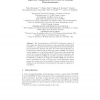Free Online Productivity Tools
i2Speak
i2Symbol
i2OCR
iTex2Img
iWeb2Print
iWeb2Shot
i2Type
iPdf2Split
iPdf2Merge
i2Bopomofo
i2Arabic
i2Style
i2Image
i2PDF
iLatex2Rtf
Sci2ools
BIRD
2008
Springer
2008
Springer
Translational Control by RNA-RNA Interaction: Improved Computation of RNA-RNA Binding Thermodynamics
The thermodynamics of RNA-RNA interaction consists of two components: the energy necessary to make a potential binding region accessible, i.e., unpaired, and the energy gained from the base pairing of the two interaction partners. We show here that both components can be efficiently computed using an improved variant of RNAup. The method is then applied to a set of bacterial small RNAs involved in translational control. In all cases of biologically active sRNA target interactions, the target sites predicted by RNAup is in perfect agreement with literature. In addition to prediction of target site location, RNAup can be also be used to determine the mode of sRNA action. Using information about target site location and the accessibility change resulting form sRNA binding we can discriminate between positive and negative regulators of translation.
| Added | 12 Oct 2010 |
| Updated | 12 Oct 2010 |
| Type | Conference |
| Year | 2008 |
| Where | BIRD |
| Authors | Ulrike Mückstein, Hakim Tafer, Stephan H. F. Bernhart, Maribel Hernandez-Rosales, Jörg Vogel, Peter F. Stadler, Ivo L. Hofacker |
Comments (0)

